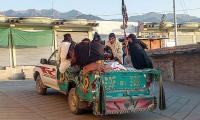The Loss and Damage Fund was set up last year at COP27. The fund aims to provide financial support to developing countries to recover from climate-led disasters.
At COP27, the setting up of the fund was declared a huge success for developing countries that are facing the brunt of climate change disasters. It also allowed such countries to have some hope that they would be compensated for socio-economic losses as a result of climate change disasters every year.
A one-year time frame – from COP27 to COP28 – was set to design and finalize modalities of the fund. The preliminary session of COP28 (Nov 30-Dec12) opened with the consensus to operationalize the Loss and Damage Fund; many countries have announced their pledges. The UAE and Germany both have pledged $100 million; Italy and France have promised to provide $108 million. The US, historically the largest emitter of greenhouse gases, has currently committed only $17.5 million. Japan has contributed $10 million.
Similarly, the EU has committed to $245.39 million, and Britain has promised at least $51 million. A total of $700 million have been pledged so far. But there is still no commitment from companies involved in greenhouse gas (GHG) emissions that are playing a significant role in global warming.
According to a UN report from 2022, combating climate change in developing countries will require an annual investment exceeding $300 billion by the year 2030.
There are several challenges to fully operationalize the L&D Fund in an effective manner. First of all, the pledged amount is far less than the required amount to support developing countries facing climate-led disasters.
According to estimates, the current total pledges make up 0.2 per cent of the financial loss caused by climate-led disasters in developing countries annually. It also depicts the hesitation of rich nations to contribute to the L&D Fund.
The committed amount is not enough to cope with damages caused by climate change as compared to the level of emissions contributed by rich nations historically.
Second, the timeline of the disbursement of the committed amount in the L&D Fund is still unclear. Developing nations are witnessing climate-led disasters every year pushing their communities into poverty traps which is increasing their financial burden. The delay in the distribution of finances will further deteriorate the situation.
According to UN Secretary General Antonio Guterres, “As people and planet continue to suffer from devastating climate impacts, our world cannot afford more delays, backtracking or greenwashing. It is time to move from promises to action.”
Third, the amount that will be distributed as a grant or loan will also determine the effectiveness of this fund. Developing nations demand that this support is provided in form of grants as they are already burdened by external loans. But rich nations also want transparency to ensure the correct utilization of these funds. Direct cash transfer can be mishandled and wasted.
Fourth, there is no defined mechanism to prioritize developing nations facing climate change disasters. The Fund will be distributed equally among nations if they witness any climate change disasters in the same year or the magnitude of the disaster will determine the share of developing nations in the Fund.
Fifth, the cash amount will be transferred to developing nations to recover from climate-led disasters or the direct transfer of technology/knowledge will be equally weighted. The Fund will be given to the government; private entities can also be considered to get a share in this Fund to take part in recovery and rehabilitation efforts in developing countries facing climate-change disasters.
Sixth, another important concern of the rich nation is transparency in the process. Many developing nations are facing challenges of corruption and incapacity to utilize this amount for the right purposes. So, without transparency and a fair process to invest in the initiative to cope with climate change disasters the Fund will fail to develop trust of rich nations.
Seventh, there are some nations who are historically not polluters but are now among the list of top polluters and economically growing as well. So, the question is: should such nations contribute to this Fund or should they get its benefits?
The L&D Fund is an important and historic achievement for developing nations like Pakistan. It is a recognition that developing nations are carrying the burden of the unsustainable development process of rich nations in the form of various climate-led disasters. But the success, sustainability and operationalization of this Fund lies on above-mentioned factors that must be clearly deliberated so that a consolidated mechanism be formulated.
The writer is a graduate of University of Oxford in Public Policy.
She tweets/posts @zilehumma_1
Election results in other countries last year forced many rulers of past to taste fruits of their karma
On December 21, Trump unleashed fresh salvo, lambasting Panama for its "unfair" canal fees
According to Unicef, estimated 22.8 million children aged 5 to 16 are out of school in Pakistan
Urdu slogan carrying incumbent PM’s name is ‘Shehbaz Karey Parwaz’, which means Shehbaz is high flier
Gender disparities are pronounced in KP, where girls account for 64% of OOSC
Chinese philosopher Mencius prophesized 3000 years ago that state that does not employ worthy perishes







